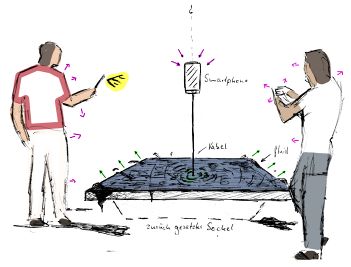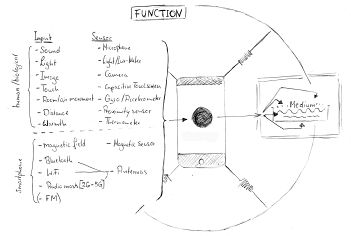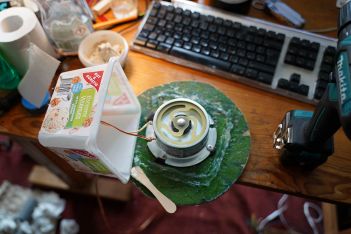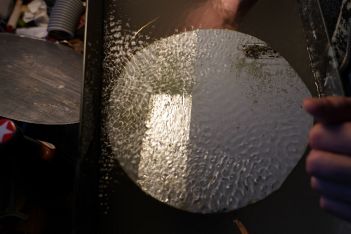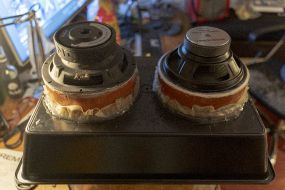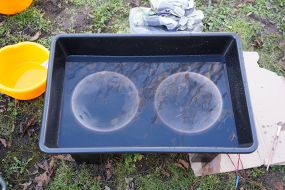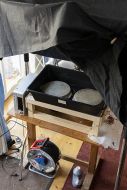|
|
| (98 intermediate revisions by 2 users not shown) |
| Line 1: |
Line 1: |
| == '''Starting Point''' ==
| | [[https://www.uni-weimar.de/kunst-und-gestaltung/wiki/GMU:Media_Art_Strategies/Leon-Etienne_Kühr/Project_old old project about telepresence]] |
|
| |
|
| | =Präsenz (Mensch + Prothese)= |
| | Entwurf für eine Installation von Leon-Etienne Kühr und Clemens Hornemann |
|
| |
|
| In real-life presence the hypertrophy of the optical sense inhibits the perception of the haptic presence. Also, our surroundings tend to fade away in times of polarized societies and contactlessness.
| |
|
| |
|
| In our project we want to convey proximity, presence, and communication beyond the means of exchanging information. Bidirectional human to human interaction through technology, a "social medium" where it does not matter who is on the other side. – Telepresence on two different (social?) places through a non-image-based system, communicating closeness via feeling and haptic.
| | ---- |
| | ==Kurzbeschreibung== |
| | Die Installation "Präsenz (Mensch + Prothese)" befasst sich mit der Untrennbarkeit physischer und digitaler Präsenz in der heutigen Zeit. |
|
| |
|
| -----
| | Ein mittig im Raum installiertes Smartphone misst die Signale und Wellen, die wir und unsere digitalen Geräte ausstrahlen. In einem Wasserbecken werden durch Interferenzmuster und Wellen die gemessenen Daten dargestellt und reagieren kurz und langfristig auf die Veränderungen im Raum — die Menschliche Präsenz als messbare Größe sichtbar gemacht. |
|
| |
|
| == '''Technical''' ==
| | ---- |
|
| |
|
| ''how can we transmit non-audiovisual sensations (back and forth)?''
| | ==Prototypen== |
|
| |
|
| We discussed different options and started studies on some of them:
| | [[File:PMP_Skizze_new.jpg|351px]] |
| | [[File:PMP_Function_b.jpg|351px]] |
|
| |
|
| | [[File:PMP_O2.JPG|351px]] |
| | [[File:PMP_O4b.jpg|351px]] |
|
| |
|
| '''air presence'''
| | [[File:PMP_P1.jpg|285px]] |
| | [[File:PMP_P2.JPG|285px]] |
| | [[File:PMP_P4.jpg|127px]] |
|
| |
|
| input: cloth with touch/optical/wind measurement - output: fans/nozzles/mechanical behind cloth
| | ---- |
| | |
| ''-> concept_01''
| |
| | |
| | |
| '''warmth'''
| |
| | |
| input: thermometer/capacitive touch - output: chill or heat from Peltier-Elements
| |
| | |
| ''-> concept_02''
| |
| | |
| | |
| '''static'''
| |
| | |
| input: static fur/styrofoam/electrorheological fluid or capacitive touch – output: static charge (e.g. from electromagnets) on the same Material
| |
| | |
| | |
| '''mechanical movement'''
| |
|
| |
| 01_benders: input: bending sensors (DIY) like blades of grass - output: the same bending sensors being bend by springs/motors/mechanical construction
| |
| | |
| 02_straws: input: current that flows when straws are touched - output: straws retract (like snail eyes) via springs/motors/ mechanical construction/compressed air
| |
| | |
| | |
| '''Thoughts:'''
| |
| *No matter which idea we choose to realise, we must balance accuracy, complexity (-> expenses, labor), recognizability, immersion vs conceptual and technical simplicity and transparency.
| |
| *If possible, input and output of human interaction should use the same medium.
| |
| *For the attractiveness of interaction, we need an appealing materiality.
| |
| | |
| -----
| |
| | |
| == Related works ==
| |
| | |
|
| |
| David Bowen - tele-present water[https://zkm.de/de/werk/tele-present-water]
| |
| | |
| Christoph Kilian - Tuchfühler / touching silk[https://christophkilian.de/tuchfuehler/]
| |
| | |
| Aaron Sherwood - Firewall[http://aaron-sherwood.com/works/firewall/]
| |
| | |
| Rafael Lozano-Hemmer - Remote Pulse[https://www.lozano-hemmer.com/remote_pulse.php]
| |
| | |
| Daniel Rozen - Mirrors [https://www.smoothware.com/danny/woodenmirror.html]
| |
| | |
| -----
| |
| | |
| == Studies // Concepts ==
| |
| | |
| | |
| 01 - "Windfang"
| |
| | |
| In “Windfang” telepresence is achieved through the interaction with cloth. At two locations a large piece of cloth is hanging from the ceiling. The viewer standing in front of the first piece of fabric can interact with it by pushing and pulling it, the movement of the fabric is then captured by an sensor/sensors and reproduced on the second cloth using multiple fans and vice versa. Therefore, the presence of the viewer is transmitted to the other viewer through the movement of air. In real-life there is a haptic presence of beings that might be felt through sudden changes in air pressure or the slight breeze caused by the movement of a body. This installation focusses on that, using cloth and air as the medium of transmitting presence to spaces beyond its reach.
| |
| | |
| | |
| [[File:windfang_skizze_1.jpg|350px]] [[File:windfang_skizze_2.jpg|350px]]
| |
| | |
| | |
| 02 - “Hitzemoment”
| |
| | |
| A room with fog/high humidity. Drops of water from the air collect on a large metal plate, cooled by a grid of peltier-elements (wiki-link) on the backside. When the surface of the plate is touched, the peltier-elements behind the point of contact switch polarity and generate heat. the water evaporates/dries at the point of contact and make the touch not only tangible but also visible. This happens in the same way, telepresent on the second installation at a different location.
| |
| | |
| Problems: resolution -> cost, energy consumption (twice for telepresence), cooling/stability of peltiers, probably not cool enough for air to condensate on, measurement of the touch not yet considered
| |
| | |
| Prototype (under construction):
| |
| | |
| [[File:Hitzemomen_skizze_Schaltung_1.jpg|350px]] [[File:hitzemoment_Prototyp_1.JPG|350px]]
| |
